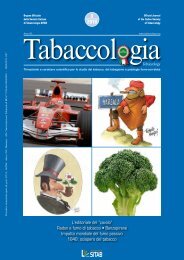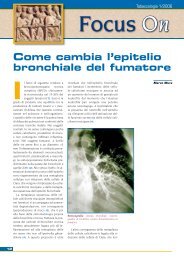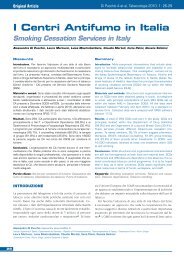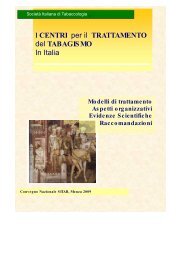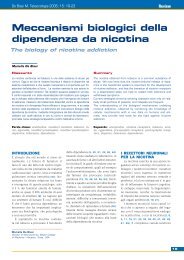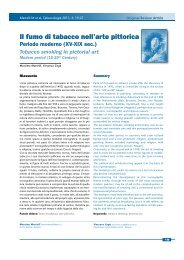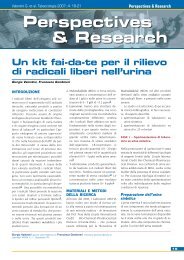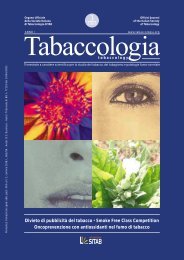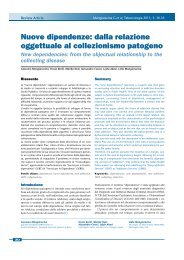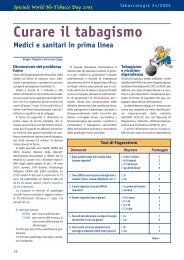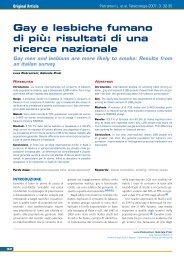Scarica n. 1/2011 - Società Italiana di Tabaccologia
Scarica n. 1/2011 - Società Italiana di Tabaccologia
Scarica n. 1/2011 - Società Italiana di Tabaccologia
You also want an ePaper? Increase the reach of your titles
YUMPU automatically turns print PDFs into web optimized ePapers that Google loves.
24<br />
Original Article<br />
Introduzione<br />
Le membrane mucose che coprono il tratto<br />
respiratorio superiore sono il punto <strong>di</strong> entrata<br />
e colonizzazione per vari agenti microbiologiche<br />
[1]. Le membrane mucose hanno<br />
un ruolo fondamentale nella risposta antimicrobica,<br />
che <strong>di</strong>pende sulla natura dell’antigene<br />
e sul potenziale effetto <strong>di</strong> agenti <strong>di</strong><br />
aggressività biologica [2]. La <strong>di</strong>pendenza dal<br />
tabacco danneggia significativamente la <strong>di</strong>fesa<br />
antibatterica delle membrane mucose,<br />
risultando in una violazione della barriera<br />
fisica ed in una <strong>di</strong>minuita migrazione e funzione secretiva<br />
da parte delle cellule fagocitarie. Questo può facilitare la<br />
persistenza <strong>di</strong> agenti estranei e l’accumulo <strong>di</strong> fattori proinfiammatori<br />
endogeni <strong>di</strong> natura immunitaria [3,4].<br />
Le tecniche <strong>di</strong> laboratorio attuali permettono un’analisi<br />
precisa delle proteine immunitarie prodotte a livello del<br />
tessuto linfoide associato alla mucosa (MALT) nel tratto<br />
respiratorio e nella saliva, sia in con<strong>di</strong>zioni normali sia<br />
in presenza <strong>di</strong> patologia. La citofluorimetria a flusso può<br />
essere utilizzata per analizzare la composizione cellulare<br />
dei prodotti della secrezione [5]. L’analisi dei fattori immunitari<br />
è un metodo non invasivo per la valutazione<br />
dell’effetto del fumo <strong>di</strong> tabacco sulle membrane mucose<br />
e sul sistema immunitario delle mucose della cavità orale,<br />
probabilmente riflettendo gli effetti sul sistema broncopolmonare.<br />
L’IL-17 è prodotta da cellule Th17. Molecole effettrici<br />
prodotte da queste cellule comprendono IL-17A, IL-17F,<br />
IL-22 e IL-26. L’IL-17 è stata scoperta nel 1993 e il suo recettore<br />
nel 1995 [9]. L’IL-17 svolge un ruole nella granulocitopoiesi<br />
e nella protezione contro patogeni extracellulari.<br />
Le IL-17F e IL-22 regolano la produzione <strong>di</strong> proteine ad<br />
attività antimicrobica nell’epitelio delle mucose. L’IL-17A<br />
stimola le cellule epiteliali nei bronchi, le cellule endoteliali<br />
venose e stimola la produzione e il rilascio dell’IL-8, la<br />
quale è chemioattrattiva per i neutrofili [9]. Inoltre, l’IL-17<br />
regola l’espressione <strong>di</strong> specifici ligan<strong>di</strong> per le chemochine<br />
CXCR1 e CXCR2, nei fibroblasti e nelle cellule epiteliali.<br />
Le CXCR1 e CXCR2 promuovono la migrazione dei leucociti<br />
nel MALT. In vitro, iniezioni <strong>di</strong> IL-17 nel fluido sinoviale<br />
hanno accelerato l’accumulo <strong>di</strong> neutrofili.<br />
Supponiamo che l’elevato livello <strong>di</strong> IL-17 nella saliva <strong>di</strong><br />
fumatori con forme iniziali <strong>di</strong> broncopneumopatia cronica<br />
ostruttiva (BPCO) possa essere un marker <strong>di</strong> gravità per<br />
l’accertamento del processo infiammatorio nella fase iniziale<br />
della malattia.<br />
Lo scopo <strong>di</strong> questo stu<strong>di</strong>o era <strong>di</strong> identificare i <strong>di</strong>sturbi<br />
dell’omeostasi immunitaria nella zona mucosalivare utilizzando<br />
l’analisi citofluorometrica <strong>di</strong> popolazioni <strong>di</strong> cellule<br />
immunitarie e l’immunoassay enzimatico quantitativo<br />
dell’interleuchina-17 (IL-17). Sono stati stu<strong>di</strong>ati campioni<br />
<strong>di</strong> saliva dei lavoratori <strong>di</strong> un impianto ra<strong>di</strong>ochimico, fumatori<br />
e con fase precoce <strong>di</strong> broncopneumopatia cronica<br />
ostruttiva, senza esacerbazioni acute.<br />
Altynbaeva E I et al, <strong>Tabaccologia</strong> <strong>2011</strong>; 1: 23-29<br />
Introduction<br />
Mucous membranes lining the upper re-<br />
spiratory tract are the entrance and colonization<br />
site for various microbial agents [1] [1].<br />
Mucous membranes play a lea<strong>di</strong>ng role in<br />
the antimicrobial response, which depends<br />
on the nature of antigen and the potential<br />
effect of biologically aggressive environmental<br />
agents [2] [2]. Tobacco dependence<br />
Altynbaeva I. Ekaterina<br />
significantly impairs the antibacterial defense<br />
of mucous membranes, resulting in<br />
a breach of the anti-microbial physical barrier<br />
and decreased migration and secretory function of<br />
phagocytosing cells. This can facilitate the persistence of<br />
foreign agents and the accumulation of endogenous proinflammatory<br />
factors of immune origin [3,4] [3,4].<br />
Current laboratory techniques allow a precise analysis<br />
of immune proteins produced at the level of mucosa-associated<br />
lymphoid tissue (MALT) in the respiratory tract<br />
and in the saliva, both under the normal con<strong>di</strong>tion and<br />
developed pathology. Flow cytofluorometry can be used<br />
to analyze the cellular composition of secretory products<br />
[5] [5]. The analysis of immune factors in the is a non-invasive<br />
method to assess the effect of tobacco smoke on the<br />
mucous membranes and mucosal immunity system in the<br />
oral cavity, possibly reflecting the effects on the bronchopulmonary<br />
system.<br />
IL-17 is produced by Th17 T cells. Effector molecules<br />
produced by these cells include IL-17A, IL-17F, IL-22 and<br />
IL-26. IL-17 was <strong>di</strong>scovered in 1993, and its receptor was<br />
identified in 1995 [9] [9]. IL-17 plays a role in granulocytopoiesis<br />
and protection against extra-cellular pathogens.<br />
IL-17F and IL-22 regulate production of antimicrobial proteins<br />
in mucous epithelium.<br />
IL-17A stimulates epithelial cells in bronchi, venous endothelial<br />
cells and stimulates the production and release<br />
of IL-8, which is chemoattractive for neutrophils [9] [9]. In<br />
ad<strong>di</strong>tion, IL-17 regulates the expression of specific chemokine<br />
ligands CXCR1 and CXCR2, in the fibroblasts and<br />
epithelial cells. CXCR1 and CXCR2 promote the migration<br />
of leukocytes into the MALT. In vitro, IL-17 injected<br />
in the synovial fluid accelerated the accumulation of neutrophils.<br />
We hypothesize that the increased level of IL-17 in saliva<br />
from smokers with early forms of chronic obstructive<br />
pulmonary <strong>di</strong>sease (COPD) could be a marker of severity<br />
for the assessment of inflammatory process at the early<br />
phase of <strong>di</strong>sease.<br />
The aim of this study was to identify <strong>di</strong>sorders of immune<br />
homeostasis in mucosalivary region by using the<br />
cytofluorometric analysis of immune cell populations and<br />
the quantitative enzyme immunoassay of interleukin-17<br />
(IL-17). Saliva samples of employees of a ra<strong>di</strong>ochemical facility,<br />
smokers and with early chronic obstructive pulmonary<br />
<strong>di</strong>sease (COPD), free from acute exacerbations were<br />
stu<strong>di</strong>ed.



